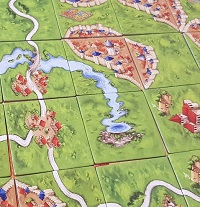Seeing things grow in front of you is always exciting and that’s one of the reasons such board games are popular. Here are the 10 Best Tile Placement Board Games in 2023.
Introduction to 10 Best Tile Placement Board Games in 2023
While tile placement is a mechanism or one of the mechanics in many board games, in this article, we’ve tried to keep it down to those that use tile placement as their main or core mechanic. This means no behemoths such as Ark Nova or A Feast of Odin, which use this mechanisc as just a part of their gameplay.
If you click on an affiliate link, it will take you to the Amazon store. If you then buy something, I will earn a commission – I am a member of the Amazon Associates program, as well as others.
10. Cacao
Complexity: light-medium
Duration: 45 minutes
Player count: 2-4, plays well at all numbers
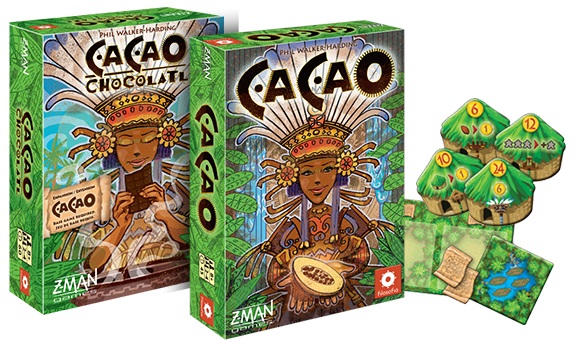
Welcome to the jungle! As chief of an exotic tribe, you’re trying to produce and sell as much cacao as possible. But besides cacao, you must not neglect temples, irrigation, and religion. And of course, neighboring tribes.
What I like most in Cacao are the two distinct types of tiles that you place on a chess-pattern board. First, there are terrain tiles with different features. Second, there are worker tiles that activate those tiles. Not only does this result in a splendid chequerboard on-table result, but it also provides very tactical gameplay without much luck.
You only ever have a choice of a few different terrain and worker tiles, so which you pick and which you save is what will make the game. As the game is played on a shared board, there are other players, who can disrupt your strategy or you can jump on an opportunity they set up.
Overall, a straightforward game to teach with plenty of depth and beauty. One of my favorites!
9. Carpe Diem
Complexity: medium
Duration: 45-75 minutes
Player count: 2-4, plays well at all numbers
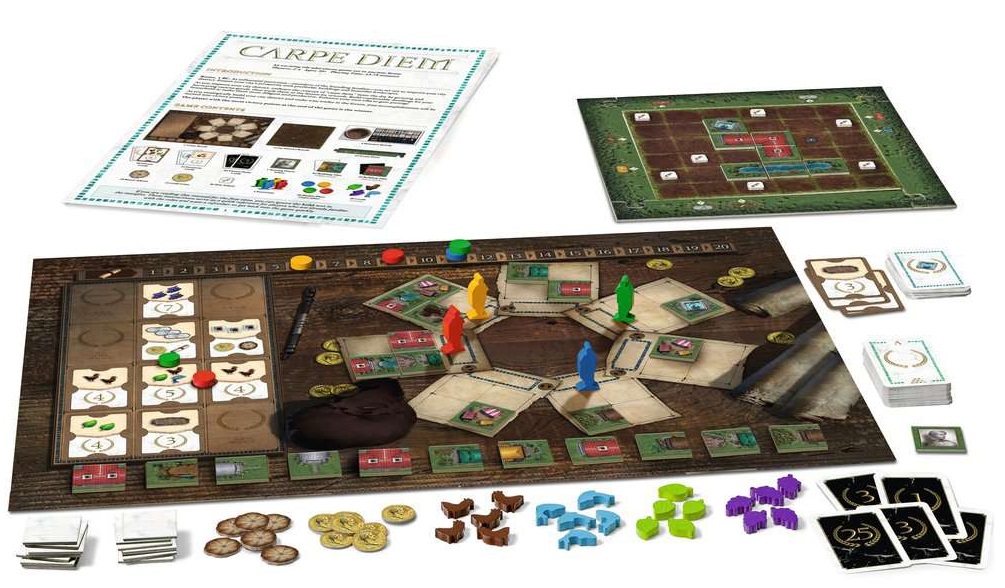
In ancient Rome, each player is a wealthy patrician, an owner of a family farm. But before you start relaxing on your porch, your estate needs enhancements: villas, chicken pens, ponds, orchards, vineyards, bakeries, and so on.
As there’s a lot to take care of in this typical Stefan Feld game, the game is quite hard to master, although the basic principles are simple. You select tiles from the central roundel and place them on your personal board, forming villas, fields, and other structures.
The tricky bit is combining your actions with scoring cards. While it takes a while to get a hang of, the game runs relatively fast and the whole process is fun and satisfying, particularly when you finally manage to score some big points.
Unfortunately, the game is not the prettiest or has an appealing theme, which is probably why it’s not very popular. But if you’re a Stefan Feld fan, you’ll love it.
8. The Isle of Cats
Complexity: light-medium
Duration: 60-90 minutes
Player count: 1-4, plays well at all numbers
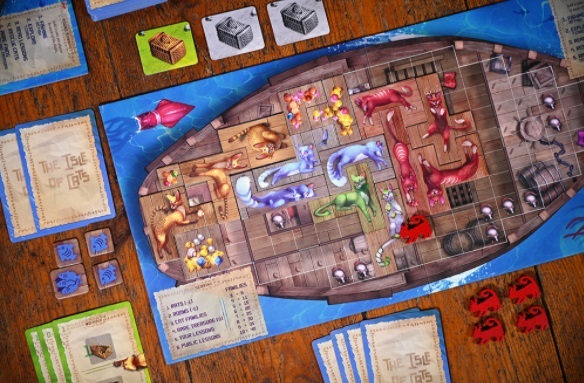
Your ship is on its way to The Isle of Cats and your job is to rescue as many cats as possible from the evil Lord Vesh, place them on your ship, and bring them to safety.
The Isle of Cats is your typical family board game: simple rules, playful appealing theme. First, you draw cards in a pick-and-pass manner. These cards give you various actions: you can rescue cats, draw objectives, treasures, and special abilities. The deck is quite thick and offers plenty of variability.
Next, you place your polyomino-shaped cats on your ship, trying to fill the grid optimally, and group the cats together by color and objectives, so that they score the most points.
As said, The Isle of Cats works perfectly as a family game. The rules are straightforward, the artwork is colorful and the cat theme very tempting. On top of that, it offers a solid strategic depth, thus making it interesting to the hardcore audience as well.
7. Kingdomino
Complexity: light
Duration: 15-25 minutes
Player count: 2-4, plays well at all numbers
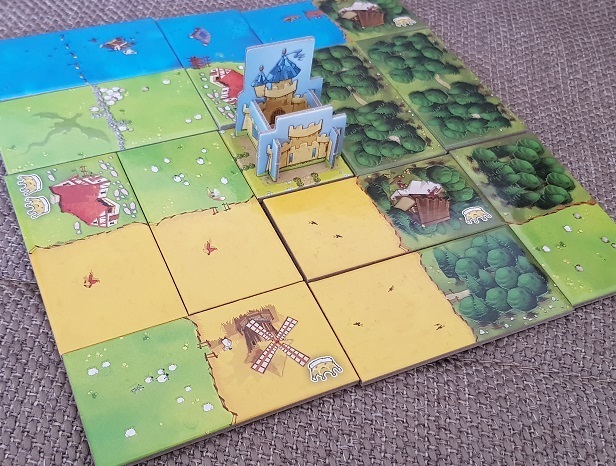
What does every king need? That’s right, a kingdom, so let’s go and build one.
Rules? Very simple. Select a tile from a display and add it to your board. So where’s the catch? The first is the mechanism of selecting tiles. The tiles are sorted by their rating (roughly their potential to score points). If you choose the most highly rated, you’ll be the last to pick a tile for the next round and vice-versa.
Second, are the various terrain types. Again, the scoring is simple: the number of connected terrain tiles times the number of crowns on them.
But combining everything together: select the right tiles at the right time so you can build a perfect 5×5 grid with a castle in the middle, not discarding any tiles, and scoring high. This is where it gets tricky and what makes Kingdomino so popular.
And if you want to spice things up, there’s the Age of Giants expansion with extra objective cards, or even Queendomino, a related, but slightly more complex game.
6. Isle Of Skye: From Chieftain to King
Complexity: light-medium
Duration: 30-50 minutes
Player count: 2-5, plays well at all numbers
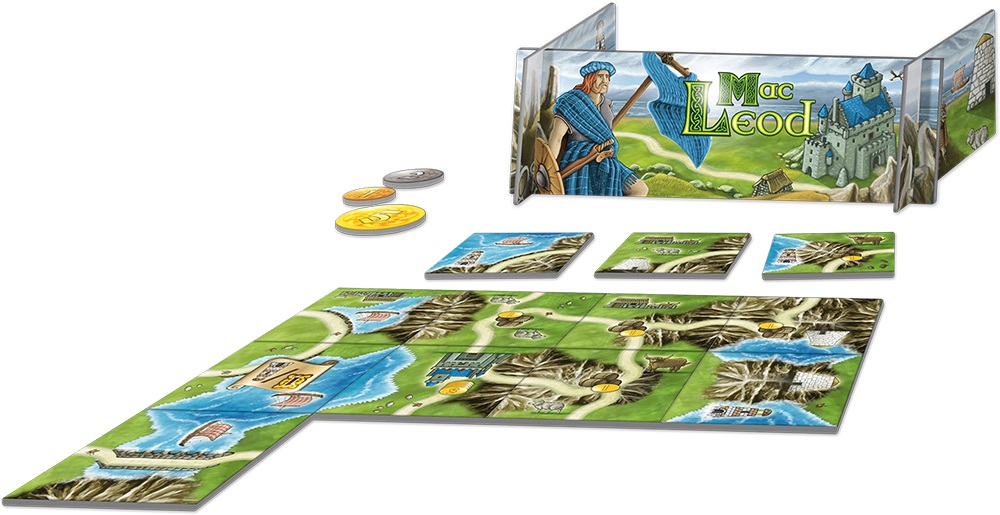
Welcome to the north of Scotland! Times are rough and clans seek to claim their dominance on the island. But you won’t fight this battle with swords – no, carefully building your territory, so that you achieve economic supremacy is the goal here.
All right, you’ve got your castle and you place tiles around it so that the terrain features on them match. So far, pretty standard. But just like Kingdomino, Isle of Skye has two aces up its sleeve.
The first one is a clever auction system. You draw three tiles, discard one, and set the prices on the other two. Then players can buy tiles from one another at those prices, which introduces interesting dilemmas into the game. You’re always weighing whether to set the price high to protect your tile, or set it low, which leaves you with more money to buy from other players.
The second ace is the dynamic round objectives, which change from game to game (you can see what they will be at all times). Adapting your tile-placing strategy, bidding, and timing to objectives is critical as they are the primary source of victory points.
Isle of Skye: From Chieftain to King is a quick-to-learn and play board game, but its clever auction system and a plethora of different objectives, make it highly replayable.
5. Carcassonne
Complexity: light-medium
Duration: 30-45 minutes
Player count: 2-5, plays well at all numbers

Our list wouldn’t be perfect with the granddaddy of tile placement, Carcassonne. Named after an idyllic southern French town, you’ll be building medieval cities with walls, roads, cloisters, and fields.
Being one of the early birds (first published in 2000), the mechanics are accordingly basic. There’s no selecting or auctioning. You draw a tile and place it somewhere on the board shared with other players so that all the features on the edges match.
To score points, you then have the option to place a worker on a feature (city, cloister, road, farm). You score points when that feature is completed – and if you’re the one with the most workers on it. Some clever tricks are available within the system so that you can get onto other players’ builds or block them, increasing competitiveness. But the gameplay is rather simplistic and anyone can learn it in a few minutes.
If this sounds rather dull – well, you’re not mistaken, it is. What lifts Carcassonne above mediocracy are the numerous expansions, adding extra tiles and mechanics. At least what you want to add are Inns & Cathedrals and Traders & Builders expansions. But, in all honesty, the best value for money is one of the Big Box compilations.
After more than 20 years, Carcassonne is still a very popular family game. You should at least try it out, preferably with a couple of expansions.
4. Patchwork
Complexity: light-medium
Duration: 15-30 minutes
Player count: 2 only
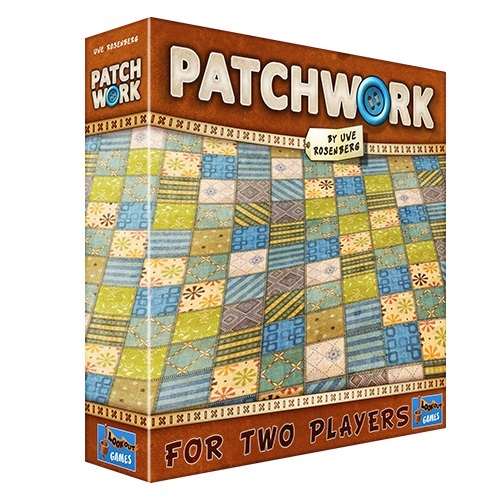
In Patchwork, a strictly two-player game, you’re building a patch of cloth on a personal board (9×9), using polyomino patches.
The tiles are laid out randomly in a circular shape and a marker is placed on a designated place in that circle. Every turn, a player can purchase one of them and place it on his board. Each tile has a cost, with more desirable patches being more expensive. A position mini-game also takes place as the marker moves on the circle of available tiles, as well as a race on the time-markers table, which dictate the order of play.
This results in an extremely tight game, where you’re trying to fit the tiles nicely together, while keeping a tab on your money, calculating how much to spend and how much you will get back in the future. But also keeping track of the other player, ensuring you don’t offer them too good of opportunities.
You’re always balancing between your money (buttons), time (initiative), and patches (available real estate). It’s about managing those three variables in an efficient matter to beat your opponent.
Although the theme is quite abstract, Patchwork is a fantastic board game for two thinky players. While it looks easy, playing it well demands a lot of skill and planning, but the end result is satisfying.
3. Cascadia
Complexity: light-medium
Duration: 30-45 minutes
Player count: 1-4, plays well at all numbers
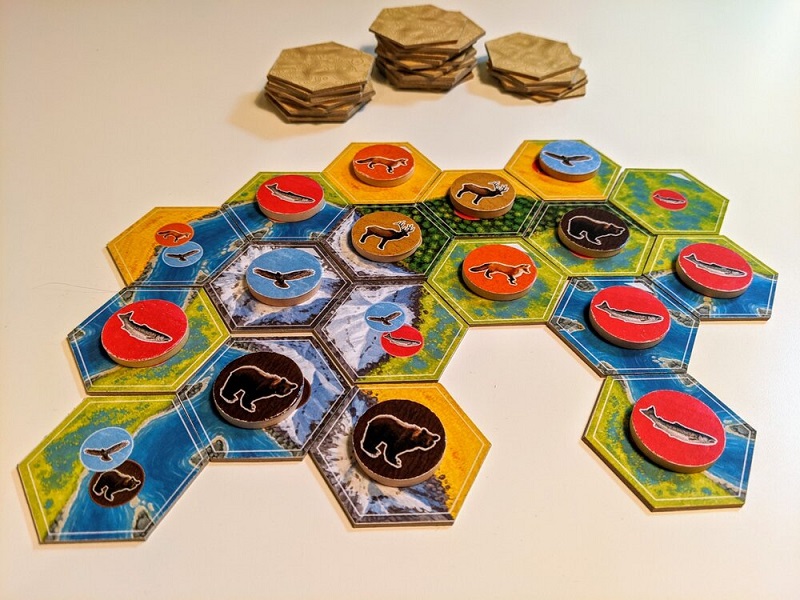
Highly regarded as one of the best board games of 2021, our P3 entrant is set in the Cascade Range mountains in North America, a wild and naturally rich environment, in both flora and fauna.
Each turn you’ll be drafting a hex/animal combo and separately adding them to your territory. You’re trying to build cohesive types, and also form patterns with various animal types. To score points, some need to form a line (salmon), others need to be in pairs (bears), and so on.
You’ll always have a choice of several hex/animal combos, and the terrain doesn’t have to match on all sides. This gives you a significant level of freedom and makes the game highly accessible to everyone – not just because of the simplicity of the rules, but also for the forgiving game mechanics.
Cascadia is perfect for a laid-back family evening, yet it is also highly modifiable for more demanding players. You can swap scoring conditions for more advanced ones, and there’s a challenging solo mode included.
2. Azul
Complexity: light-medium
Duration: 30-45 minutes
Player count: 2-4, plays well at all numbers
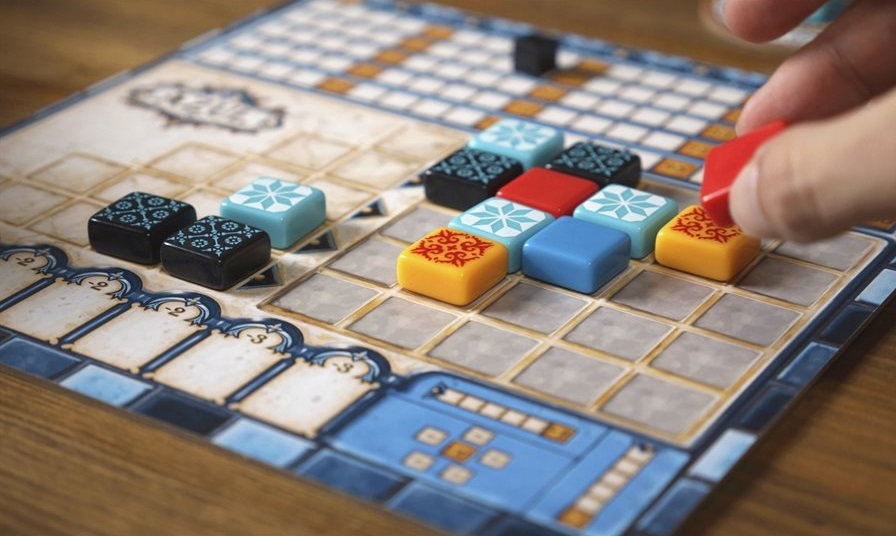
Azul is a board game that takes the tile placement mechanic most literally. It’s an abstract game of placing the tiles on your board, and scoring points for various patterns. Still, the designers have squeezed every drop out of the theme. The tiles look and feel great and the whole game is a joy to behold.
Each turn, you collect a set of tiles from the central offer, then you place them into five rows on the left side of your player board. The top row requires only one tile to fill, the second requires two, all the way down to the fifth, which requires five tiles of the same color to fill.
When there are no more tiles on offer, the round ends, and filled rows are scored. Before they are emptied, one tile from each row is moved to the right side, where the bulk of your points will come from, forming rows, diagonals, colors, and other patterns.
The gameplay starts as a solitaire set-collecting, but as the game progresses and players fill their boards, Azul becomes more competitive and tense, yet never becomes mean. There’s always an alternative tile to take.
Azul is a joy to play and has quickly become a modern classic, with several sequels confirming the quality of the concept. The rules are easy to understand by everyone – collect these tiles of the same color until you have enough to fill a row. But scoring those big points is deceivingly hard.
1. The Castles of Burgundy
Complexity: medium
Duration: 30-90 minutes
Player count: 2-4, plays well at all numbers
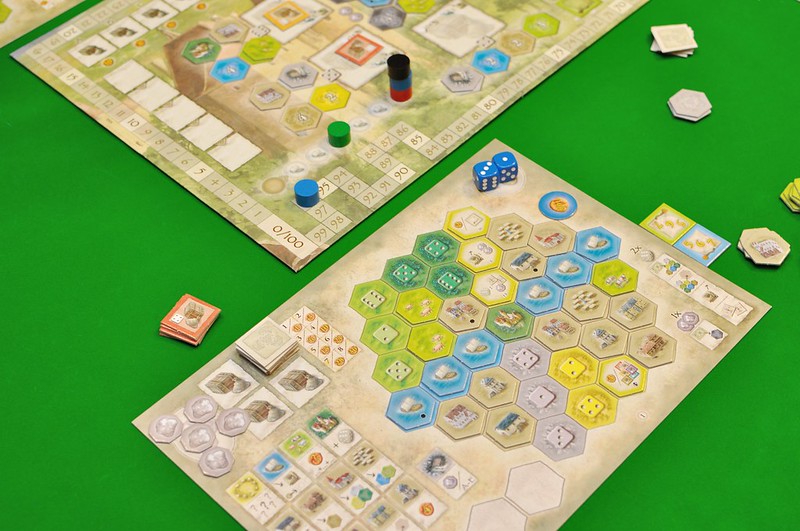
If the theming and packaging are tools to make the game appealing and compelling to buyers, then the creators of Castles of Burgundy could have used them better, to say the least. But the game’s appearance is just another example that it’s not all in the looks and it is highly successful, despite that.
Beneath a bland theme, plain art, and basic components, lies one of the best board games of all time. It combines tile placement with dice placement, or more precisely, using dice as workers.
With each turn, you will roll your two worker dice. You can use them to take hex tiles from the offer and place tiles on your estate. But the pips on the dice determine from which depot you can take a hex and where on your board can you place one.
There are several types of hexes (castles, buildings with their free actions, knowledge tiles with special abilities, ships with goods that can be sold for points, animals, and mines), and the game is about completing areas of similar types of hexes, all hexes of a single type, or even several different types combined with synergetic special abilities, for those big scores.
But, being a Stefan Feld game, doing well is very hard. Although you can mitigate a bad roll to an extent, you normally have to make do with what you roll and combine your two actions per turn optimally. In that regard, the game is highly tactical, but also strategical – should you focus on sheep, since there are several available? Or will you build your strategy around ships and sell trade goods for points?
The Castles of Burgundy offers many paths to victory and is simple to learn, but super challenging to master. To increase variety, there are several player boards available. There are even newer, “nicer” editions of the game, that mitigate the looks grievances from the beginning. It’s a must-play for every board gamer.
